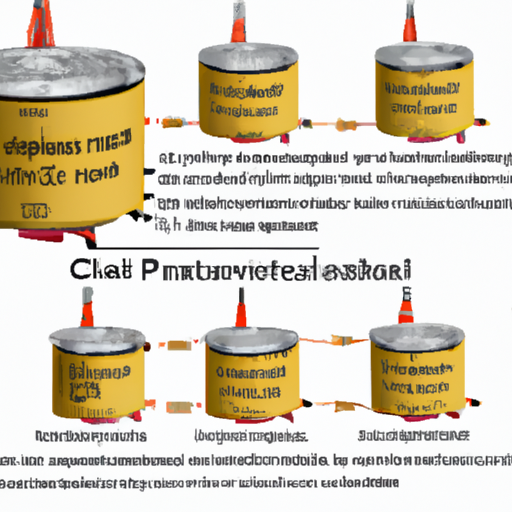Title: The Latest Innovations in Film Capacitor Technology: A Comprehensive Specification Guide

1. Film Capacitor Basics (200 words) Before delving into the latest specifications, it is crucial to understand the fundamentals of film capacitors. Film capacitors are constructed using a thin dielectric film, which separates two conductive layers. This dielectric film can be made from various materials, such as polyester, polypropylene, or polycarbonate, each offering unique electrical properties.
2. Voltage Ratings and Capacitance (200 words) Voltage ratings and capacitance are two critical specifications that determine the performance of film capacitors. The latest advancements have led to the development of film capacitors with higher voltage ratings, allowing for their use in demanding applications such as power electronics and renewable energy systems. Additionally, manufacturers have been able to increase the capacitance values while maintaining compact sizes, enabling greater energy storage capabilities in smaller form factors.
3. Temperature Stability and Self-Healing Properties (300 words) Film capacitors are often subjected to extreme temperature variations, making temperature stability a crucial specification. The latest film capacitors exhibit improved temperature stability, ensuring reliable performance even in harsh environments. Furthermore, self-healing properties have been enhanced, enabling the capacitors to recover from minor dielectric breakdowns, thus extending their lifespan and reducing the risk of catastrophic failures.
4. Low ESR and ESL (300 words) Equivalent Series Resistance (ESR) and Equivalent Series Inductance (ESL) are critical parameters that affect the efficiency and performance of film capacitors. The latest advancements have led to the development of film capacitors with significantly reduced ESR and ESL values, resulting in improved power handling capabilities and reduced losses. These low ESR and ESL characteristics make film capacitors ideal for high-frequency applications, such as in power supplies and electric vehicle charging systems.
5. Miniaturization and High Energy Density (300 words) As electronic devices become smaller and more compact, the demand for miniaturized capacitors with high energy density has increased. Manufacturers have responded to this demand by developing film capacitors with reduced dimensions while maintaining high capacitance values. These advancements have allowed for the integration of film capacitors in space-constrained applications, such as smartphones, wearables, and IoT devices.
6. Safety and Reliability (200 words) Safety and reliability are paramount in any electronic component. The latest film capacitors adhere to stringent safety standards, ensuring protection against electrical shocks, short circuits, and thermal runaway. Additionally, manufacturers have implemented advanced manufacturing techniques and quality control processes to enhance the reliability and longevity of film capacitors, reducing the risk of premature failures.
Conclusion (100 words) In conclusion, the latest developments in film capacitor technology have revolutionized the industry, offering improved specifications that cater to the evolving needs of modern electronic devices. From higher voltage ratings and capacitance values to enhanced temperature stability and self-healing properties, film capacitors have become more efficient, reliable, and compact. As technology continues to advance, we can expect further innovations in film capacitor specifications, enabling the seamless integration of these essential components in a wide range of applications, from consumer electronics to industrial systems.
Title: The Latest Innovations in Film Capacitor Technology: A Comprehensive Specification Guide

1. Film Capacitor Basics (200 words) Before delving into the latest specifications, it is crucial to understand the fundamentals of film capacitors. Film capacitors are constructed using a thin dielectric film, which separates two conductive layers. This dielectric film can be made from various materials, such as polyester, polypropylene, or polycarbonate, each offering unique electrical properties.
2. Voltage Ratings and Capacitance (200 words) Voltage ratings and capacitance are two critical specifications that determine the performance of film capacitors. The latest advancements have led to the development of film capacitors with higher voltage ratings, allowing for their use in demanding applications such as power electronics and renewable energy systems. Additionally, manufacturers have been able to increase the capacitance values while maintaining compact sizes, enabling greater energy storage capabilities in smaller form factors.
3. Temperature Stability and Self-Healing Properties (300 words) Film capacitors are often subjected to extreme temperature variations, making temperature stability a crucial specification. The latest film capacitors exhibit improved temperature stability, ensuring reliable performance even in harsh environments. Furthermore, self-healing properties have been enhanced, enabling the capacitors to recover from minor dielectric breakdowns, thus extending their lifespan and reducing the risk of catastrophic failures.
4. Low ESR and ESL (300 words) Equivalent Series Resistance (ESR) and Equivalent Series Inductance (ESL) are critical parameters that affect the efficiency and performance of film capacitors. The latest advancements have led to the development of film capacitors with significantly reduced ESR and ESL values, resulting in improved power handling capabilities and reduced losses. These low ESR and ESL characteristics make film capacitors ideal for high-frequency applications, such as in power supplies and electric vehicle charging systems.
5. Miniaturization and High Energy Density (300 words) As electronic devices become smaller and more compact, the demand for miniaturized capacitors with high energy density has increased. Manufacturers have responded to this demand by developing film capacitors with reduced dimensions while maintaining high capacitance values. These advancements have allowed for the integration of film capacitors in space-constrained applications, such as smartphones, wearables, and IoT devices.
6. Safety and Reliability (200 words) Safety and reliability are paramount in any electronic component. The latest film capacitors adhere to stringent safety standards, ensuring protection against electrical shocks, short circuits, and thermal runaway. Additionally, manufacturers have implemented advanced manufacturing techniques and quality control processes to enhance the reliability and longevity of film capacitors, reducing the risk of premature failures.
Conclusion (100 words) In conclusion, the latest developments in film capacitor technology have revolutionized the industry, offering improved specifications that cater to the evolving needs of modern electronic devices. From higher voltage ratings and capacitance values to enhanced temperature stability and self-healing properties, film capacitors have become more efficient, reliable, and compact. As technology continues to advance, we can expect further innovations in film capacitor specifications, enabling the seamless integration of these essential components in a wide range of applications, from consumer electronics to industrial systems.